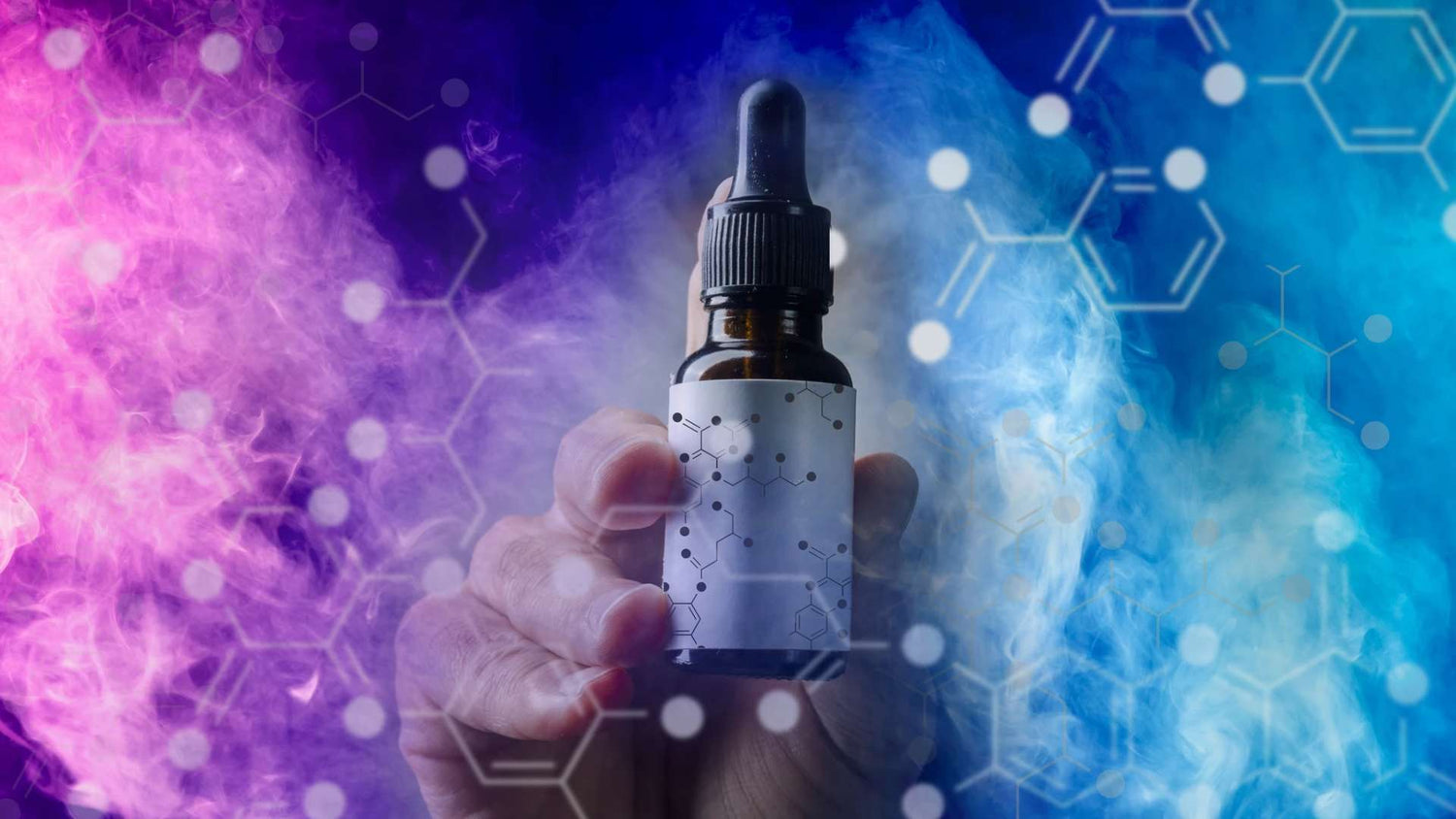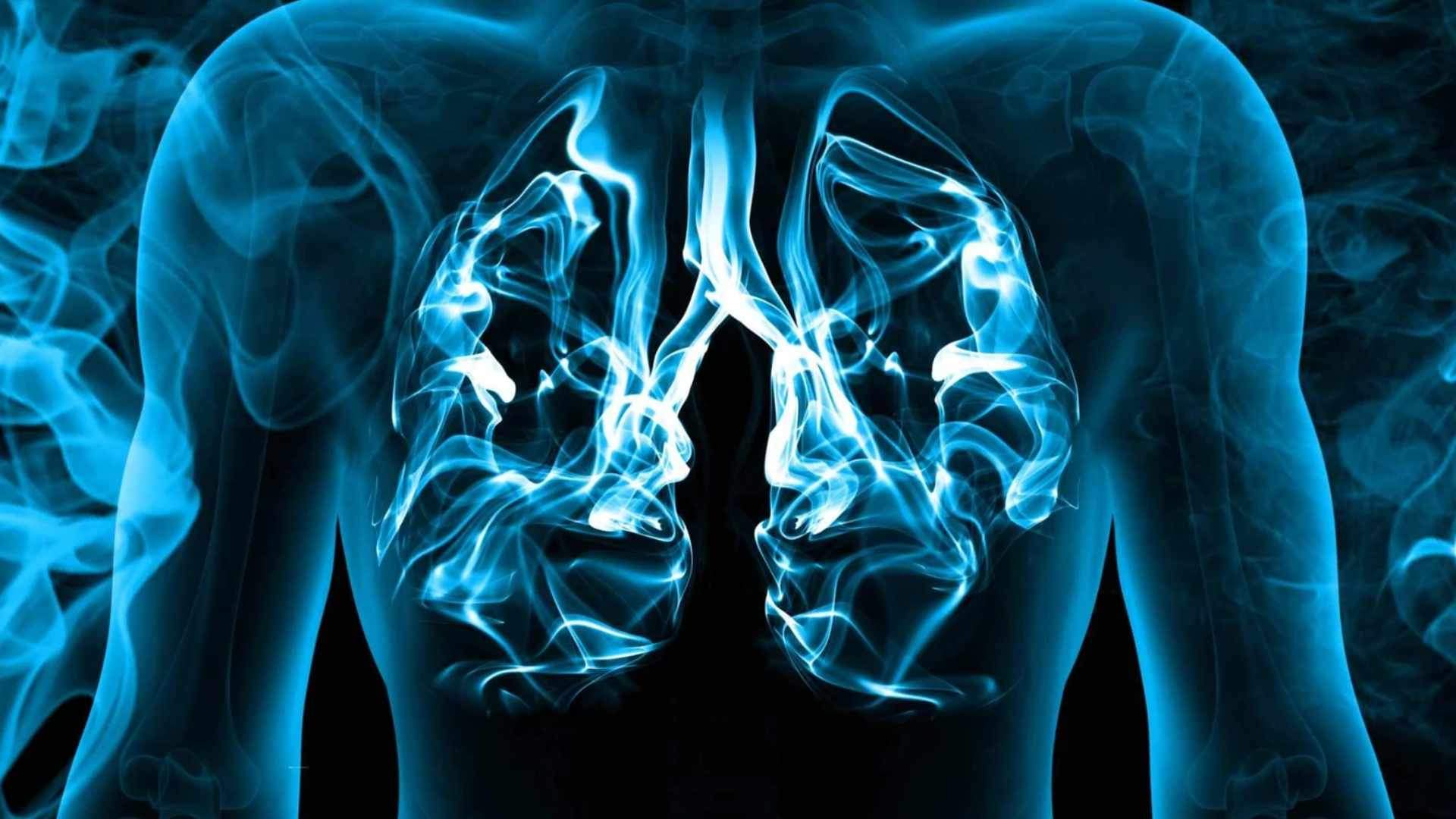Vape juice also referred to as e-juice or e-liquid has four main ingredients:
Vape juice is a viscous liquid that is used to fill an electronic cigarette or vape to deliver nicotine. Not to forget, you can always get vape juice without nicotine as well. The e-liquid is heated in the vape to generate a cloud of vapor.


You might be wondering, are the chemicals in vape juice safe to vape?
Before we dive into each of these vape juice ingredients, it’s important to know that all of these chemicals are considered “Generally Recognized As Safe (GRAS)” by the FDA for human ingestion. However, the health effects of vaporizing or smoking these chemicals are not fully understood.
By the end of this article, you will understand:
- Each ingredient in your e-juice
- What it’s used for?
- How it affects your vaping experience?
We’ll start off with vegetable glycerin and propylene glycol since it makes up the majority of your e-juice content. Both of which are used as a humectant (substance to preserve moisture) in everyday household items for food and cosmetic products.
Vegetable Glycerin (VG)

What is Vegetable Glycerin (VG)?
- Vegetable glycerin (VG) or Glycerol is a clear and thick liquid typically derived from soybeans or palm trees. It can also be made from animal fat although less common.
- A lot of people confuse this with vegetable oil because of the thick and syrupy texture, but VG is not the same as vegetable oil. Glycerol is water soluble whereas vegetable oil is not.
- VG is approved by the FDA as a “generally recognized as safe” chemical for human ingestion. However, the health effects of inhaling Glycerol or VG is not known.
What is VG used for?
- Glycerol is used in the food industry as a sweetener due to it leaving a slightly sweet aftertaste. It’s also used as a food additive to retain moisture, help foods thicken and homogenize different ingredients.
- In the pharmaceutical industry, Glycerol is used in skin cream to preserve moisture as well as increasing solubility of other ingredients to make it more absorbable by the skin.
- VG is a household ingredient found in personal care products: makeup, shampoo, deodorant, soap, skin and hand cream, toothpaste, and eye drops.
- VG is also found in food products such as baked goods, cheese, yogurt, gel capsule pills, and other processed foods.
How does VG affect your vaping experience?
- VG affects the amount of vapor produced due to the viscosity of the liquid. The higher the VG ratio, the thicker the clouds. Vapers who are cloud-chasers will use high VG ratio in sub-ohm vapes to get large and plumy clouds.
- VG is also known for its soft and smoother throat hit.
- Due to the thickness of VG, it will make it harder for your vape coil to wick which can cause dry hits. Thus, a high VG ratio will take longer for the cotton in your vape coil to be saturated.
- It’s also important to mention that VG will make it harder to clean your tank compared to PG because of its goopy consistency.
Propylene Glycol (PG)
What is Propylene Glycol?
- Propylene Glycol is a colorless and odorless liquid derived from petroleum with a faintly sweet taste. PG has a syrupy texture but is runnier compared to vegetable glycerin.
- Propylene Glycol is often confused with a toxic chemical found in antifreeze called Ethylene Glycol. Due to the high toxicity of ethylene glycol, many manufacturers are now using an alternative called Propylene glycol. PG is a chemical that is used in products for people and pets whereas ethylene glycol requires proper handling.
- Propylene glycol is a chemical approved by the FDA for human ingestion, and it is not considered cancerous. As for inhaling PG, the long-term health effects are not yet known.
What is PG used for?
- PG is commonly used as a food additive due to its ability to retain moisture, making ingredients thicker, as well as bonding different ingredients together.
- Foods using PG as an additive: salad dressing, ice cream, soft drinks, packaged frosting, boxed cake mix, commercial food coloring.
- Cosmetic products that use PG: shampoo, lotion, mouthwash, ointments, toothpaste, and deodorant.
How does PG affect your vaping experience?
- PG is used as a vehicle in e-juices to carry the flavoring. Thus, the higher the PG ratio, you’ll get a sharper flavor compared to VG.
- An increase in PG is also associated with a stronger throat hit that is similar to inhaling tobacco smoke.
- PG is thinner in consistency compared to VG and is much easier to clean off your vape. If you are vaping with a high PG ratio, you may also run into leaking issues depending on the vaping device you are using.
- Some people are sensitive to PG, and if you have allergic symptoms such as a sore throat or skin irritation, it may be best to opt for an e-juice with higher VG ratio.

Read more on PG and VG: The difference between PG vs VG
Flavoring

What are flavoring concentrates?
- Flavoring concentrates in e-juices use a combination of natural and artificial flavoring to replicate the taste of a food or drink.
- E-juice manufacturers use ‘food grade’ or ‘GRAS’ flavoring concentrates approved by FEMA (flavour extracts manufacturers association). Although the flavoring concentrates are food grade, the effects of inhalation of these concentrates are not fully understood.
What are flavoring concentrates used for?
- Flavoring concentrates are found in baked goods, soda, candy, and any processed foods that have some sort of artificial flavoring.
- When vape juice flavors are created, a simple flavor such as strawberry can take a combination of different flavoring concentrates to replicate the feeling of eating a strawberry. Mixology is a science and an art.
How does flavoring concentrates affect your vaping experience?
- Flavoring concentrates make up no more than 10% of the total e-juice content.
- E-juices does not use oil-based flavorings.
- Flavorings part of the diketone family such as diacetyl, acetoin, and acetyl propionyl are ingredients known to be hazardous if inhaled. Diacetyl became a health hazard in the media when workers from a microwave popcorn factory started to contract a rare lung disease called popcorn lung or bronchiolitis obliterans.
- The amount of diacetyl found in cigarettes is 10-100 times more than any e-juice found.
Nicotine

What is nicotine?
- Nicotine is an alkaloid found in the nightshade family of plants such as tomatoes, eggplants, potatoes, and tobacco.
- Nicotine is a highly addictive substance and one of the main reasons why cigarettes are difficult to quit.
- Nicotine is considered a stimulant but also works to relax a person as well.
- Many people wrongly assume that nicotine is what causes cancer in cigarettes but it’s the tar and other additives in cigarettes that have carcinogenic properties when inhaled. Nicotine is highly addictive, but there are no scientific studies to support that nicotine causes cancer.
What is nicotine used for?
- To help smokers quit, nicotine is used in nicotine gum, nicotine inhalers, nicotine patches, and e-liquid.
- Quitting cigarettes cold turkey is difficult due to strong nicotine cravings.
- Nicotine is used in vape juices and other nicotine replacement therapies to aid people in quitting cigarettes. Many people vape to get the smoking sensation as well as getting nicotine in a less harmful manner.
Because nicotine in vape juice is used as a quitting aid, 0 nic vape juice is also available. It can be used as the last step to lowering your nicotine intake for good.
How does nicotine affect the vaping experience?
- Vaping nicotine can come in different levels such as 0 mg, 3 mg, 6 mg, and 12 mg.
- Not all vape juices contain nicotine as you can order 0 mg nicotine e-juices if you were to quit nicotine but still keep the smoking sensation.
- The higher the nicotine levels, the harsher the throat hit. Nicotine has a peppery taste and can make the flavor harsher.
- There are two kinds of nicotine: freebase nicotine and nicotine salts.
- Freebase nicotine is also referred to as regular nicotine and is the most commonly found in 0 mg, 3 mg, 6 mg, and 12 mg.
- Nicotine salts are relatively new and what makes them different from regular nicotine (freebase) is that vapers can vape at higher nicotine strengths without getting the harsh taste as you would with freebase nicotine. It is the closest vaping experience that delivers nicotine as a cigarette would.
- Nicotine salts also are known as nic salts. Nic salts are commonly found in the 25 - 50 mg nicotine strengths.
- All e-juice bottles are required to be child-proofed to avoid children from drinking e-juice bottles Nicotine overdose in children can be fatal.
- If you would like to know how to choose the right nicotine strength, read more about it here!
About Ruthless Vapor
Ruthless Vapor is a premium e-juice brand manufacturing for over 30 brands in the industry. Ruthless sells in over 60 countries and have been bringing all day vapes since 2011.
As a veteran of the game, Ruthless sources only the finest ingredients when it comes to VG, PG, Flavoring, and Nicotine to make sure you are getting high-quality e-juice. We produce our e-liquids in an ISO 7 certified state of the art clean room, and we practice a stringent quality control process to ensure you are vaping only the best!




6 comments
Shannon
Thank you for breaking this down for me. 😀 I’m a heavy smoker moving to vape in hopes I can taper down to no nic. 😏 Anyway, I guess I’m hoping these chemicals are less harsh than my PallMalls. I’m reading scary articles of formaldehyde etc. Is there a way to find out what exactly is in my vape juice?
Leave a comment
All comments are moderated before being published.
This site is protected by hCaptcha and the hCaptcha Privacy Policy and Terms of Service apply.